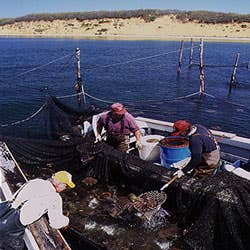
Fishing the Pound Trap
When I call Stewart Lester to ask if I can photograph him out fishing, he says, "Just be at Brent's in Amagansett any morning at 6 a.m. I've got a red pickup. You'll smell it before you see it." The next day, at six straight up, a truck towing a sharpie—a 16-foot wooden work boat—pulls up at Brent's General Store. Stewart and his son, Ted, head for the coffeepot, and are out the door before I even get to introduce myself. I follow the trucks to their mooring, off the boat ramp at Lazy Point in Napeague, and make contact. Stewart climbs into his 24-footer; Ted fires up his 17-footer. I join Ted and we head out into Gardiners Bay. The men are not happy. The wind is up; four-foot swells splash over the bow, soaking us. "I'm not sure we'll be able to get into the nets," Stewart worries.
Their pound traps are a configuration of poles and nets that I've long seen in these waters but never fully understood. The basics haven't changed much from old Indian techniques: A leader—a line of stakes spaced 25 feet apart, connected by a net—runs 500 feet straight out from the beach. The thick leader poles are sunk deep into the sand, anchoring the net to the bottom to form a wall. The leaders, up to 40 feet long, are cut from land around East Hampton. (In 1686, King James II gave baymen and farmers the right to cut wood anywhere, for fishing and firewood. In theory, they can walk onto any millionaire's summer place and cut down all the trees they need.) Big fish like to feed in shallow water—but when they see the poles, they head for deeper water and run into a four-sided maze called the "heart" or "inner-pound"—then into the 20-foot mouth of a funnel net, which narrows to 3 1⁄2 feet, then into a 20-by-32-foot pen with a net on four sides and the bottom.
Ted and Stewart are grumbling. Nor'easters have pounded the East End for six straight days, so they couldn't get out to check their traps. "I've never not been able to go out for so long," says Stewart. "Never." Now they're working against the clock. Today is Thursday, the day of the week's last truck to Manhattan's Fulton Fish Market. If they miss it, they'll have to store their fish for the weekend. Another problem: Their catch will be much larger than usual, and their boats have no holding tanks.
At the traps, their worst fears are realized. Pulling up the nets by hand is an intense struggle—first freeing them from the sand, then lifting thousands of pounds of fish, including "junk" to be thrown back: crabs, skate, striped bass under 24 or over 36 inches, fluke under 14. They seem to throw back ten fish for every keeper, scrambling for the squid and blowfish the stripers haven't eaten. Ted predicts the blowfish will bring $6 a pound—but Stewart saves them for his wife to cook up.
After four hours of back-breaking work, the decks of both boats are covered with fish. The Lesters return with ten times the usual haul—176 pounds of fluke, 53 of bluefish, 24 each of porgies and weakfish, and 800 pounds of bunkers, which they'll salt as bait for their 380 lobster traps. (The Department of Environmental Conservation requires fish to be sorted by species before landing.) They load up Stewart's truck and make a beeline for The Seafood Shop in Wainscott, where they sell their entire haul of bluefish (65 cents a pound) and some weakfish ($1 a pound)—and where they meet the Fulton Fish Market truck, just in time.
Keep Reading
Continue to Next Story










